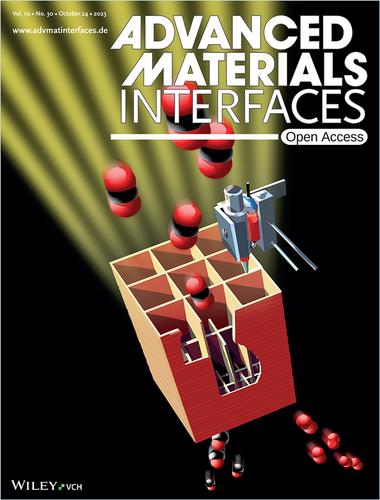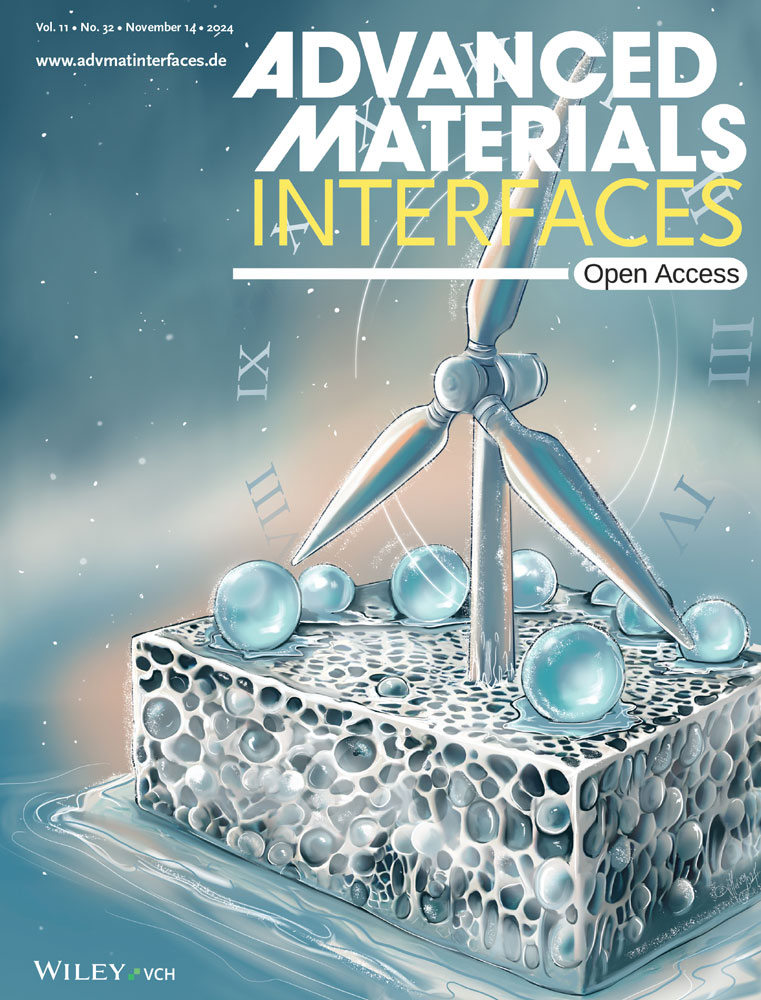使用3D打印的分层通道Ceria结构的太阳能驱动的CO2氧化还原分裂(Adv.Mater.Interfaces 30/2023)
IF 4.3
3区 材料科学
Q2 CHEMISTRY, MULTIDISCIPLINARY
引用次数: 0
摘要
CO2太阳能燃料的氧化还原裂解是通过使用集中太阳辐射的热化学氧化还原循环由CO2和H2O产生的。在文章2300452中,Steinfeld、Studart及其同事通过使用集中太阳辐射的热化学氧化还原循环,从CO2和H2O中生产太阳能燃料。太阳能反应器包含一个由二氧化铈制成的结构,该结构具有太阳能吸收器和氧化还原材料的功能。通过直接墨水书写3D打印的分层通道二氧化铈结构能够实现有效的体积辐射吸收,从而提高太阳能反应堆的比燃料产量。本文章由计算机程序翻译,如有差异,请以英文原文为准。

Solar-Driven Redox Splitting of CO2 Using 3D-Printed Hierarchically Channeled Ceria Structures (Adv. Mater. Interfaces 30/2023)
Redox Splitting of CO2
Solar fuels are produced from CO2 and H2O via a thermochemical redox cycle using concentrated solar radiation. In article 2300452, Steinfeld, Studart, and co-workers produced solar fuels from CO2 and H2O via a thermochemical redox cycle using concentrated solar radiation. The solar reactor contains a structure, made of ceria, which serves the functions of solar absorber and redox material. Hierarchically channeled ceria structures, 3D-printed by direct ink writing, enable efficient volumetric radiative absorption, thereby augmenting the specific fuel yield of the solar reactor.
求助全文
通过发布文献求助,成功后即可免费获取论文全文。
去求助
来源期刊

Advanced Materials Interfaces
CHEMISTRY, MULTIDISCIPLINARY-MATERIALS SCIENCE, MULTIDISCIPLINARY
CiteScore
8.40
自引率
5.60%
发文量
1174
审稿时长
1.3 months
期刊介绍:
Advanced Materials Interfaces publishes top-level research on interface technologies and effects. Considering any interface formed between solids, liquids, and gases, the journal ensures an interdisciplinary blend of physics, chemistry, materials science, and life sciences. Advanced Materials Interfaces was launched in 2014 and received an Impact Factor of 4.834 in 2018.
The scope of Advanced Materials Interfaces is dedicated to interfaces and surfaces that play an essential role in virtually all materials and devices. Physics, chemistry, materials science and life sciences blend to encourage new, cross-pollinating ideas, which will drive forward our understanding of the processes at the interface.
Advanced Materials Interfaces covers all topics in interface-related research:
Oil / water separation,
Applications of nanostructured materials,
2D materials and heterostructures,
Surfaces and interfaces in organic electronic devices,
Catalysis and membranes,
Self-assembly and nanopatterned surfaces,
Composite and coating materials,
Biointerfaces for technical and medical applications.
Advanced Materials Interfaces provides a forum for topics on surface and interface science with a wide choice of formats: Reviews, Full Papers, and Communications, as well as Progress Reports and Research News.
 求助内容:
求助内容: 应助结果提醒方式:
应助结果提醒方式:


